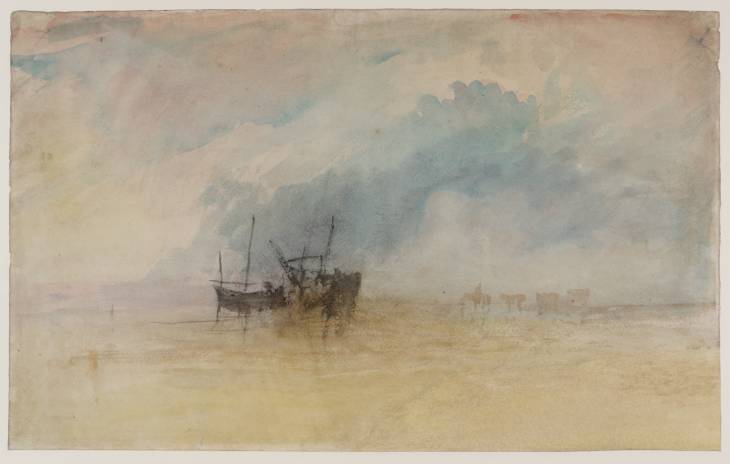Joseph Mallord William Turner ?Flint Castle c.1834-5
Joseph Mallord William Turner,
?Flint Castle
c.1834-5
Joseph Mallord William Turner 1775–1851
?Flint Castle c.1834–5
D36319
Turner Bequest CCCLXV 28
Turner Bequest CCCLXV 28
Watercolour and chalk on white wove paper, 304 x 489 mm laid down on a similar sheet
Watermark ‘J Whatman | 1828’
Stamped in black ‘CCCLXV 28’ bottom right (above torn edge)
Watermark ‘J Whatman | 1828’
Stamped in black ‘CCCLXV 28’ bottom right (above torn edge)
Accepted by the nation as part of the Turner Bequest 1856
Exhibition history
1975
Turner in the British Museum: Drawings and Watercolours, Department of Prints and Drawings, British Museum, London, May 1975–February 1976 (104, reproduced as ‘A group of sailing-boats stranded on a beach’, c.1825).
2002
Turner: Reflections of Sea and Light: Paintings and Watercolors by J.M.W. Turner from Tate, Baltimore Museum of Art, February–May 2002 (no catalogue).
2002
Turner y el mar: Acuarelas de la Tate, Fundación Juan March Madrid, September 2002–January 2003 (51, reproduced in colour, as ‘Barcos encallados en el arenal’, c.1830).
2003
O mar e a luz: Aguarelas de Turner na colecção da Tate, Museu Calouste Gulbenkian, Lisbon, February–May 2003 (53, reproduced in colour, as ‘Stranded Vessels on the Sands’, c.1830).
References
1909
A.J. Finberg, A Complete Inventory of the Drawings of the Turner Bequest, London 1909, vol.II, p.1213, CCCLXV 28, as ‘Stranded vessels ... Right-hand bottom corner torn’, after about 1830.
1975
Andrew Wilton, Turner in the British Museum: Drawings and Watercolours, exhibition catalogue, Department of Prints and Drawings, British Museum, London 1975, pp.72–3, (no.104, reproduced as ‘A group of sailing-boats stranded on a beach’. c.1825).
1997
Eric Shanes, Turner’s Watercolour Explorations 1810–1842, exhibition catalogue, Tate Gallery, London 1997, pp.97, 107, 156 (p.97 Appendix I under ‘England and Wales Series’, as ‘?Study for Flint Castle, North Wales’. c.1835, p.107 Appendix II, as ‘Study?: ?Flint Castle, North Wales’).
2004
Eric Shanes, Turner: The Life and Masterworks, New York 2004, p.156.
Andrew Wilton noted that the ‘figure on horseback and train of animals suggests a location such as Lancaster Sands’1 – see the watercolour Lancaster Sands of about 1818 (Birmingham Museums and Art Gallery),2 and another of about 1826 (British Museum, London),3 engraved in 1828 for the Picturesque Views in England and Wales (Tate impressions: T04534, T04535).
However, the principal focus in both Lancaster Sands works is a stagecoach, not hinted at here. Eric Shanes has instead, tentatively at first, compared this colour study to the watercolour Flint Castle, North Wales of about 1834–5 (National Museum Wales, Cardiff),4 engraved in 1836 for England and Wales (Tate impressions: T05873, T06121).5 The castle, which Turner had first visited in 1794,6 stands on the Welsh west bank of the broad, tidal Dee Estuary. Later Shanes was more conclusive, noting ‘the beached boats in the centre distance, the adjacent horses and carts (but facing in the opposite direction), a rather stormy sky and the castle represented in misty, light silhouette.’7 Assuming a connection, the overall effect here is relatively simple and naturalistic compared with the complex virtuoso rendering of the sun, clouds and reflections in the England and Wales watercolour.
For a possible Lancaster Sands ‘colour beginning’, see Tate D25132 (Turner Bequest CCLXIII 10). A ‘colour beginning’ comprising only sea and sky which has been linked to a variant watercolour of about 1830 showing Flint Castle (private collection)8 is Tate D35986 (Turner Bequest CCCLXIV 143). See also the introductions to the present subsection of identified subjects and the overall England and Wales ‘colour beginnings’ grouping to which this work has been assigned.
Technical notes:
The missing, torn bottom right corner noted by Finberg, extending to the bottom centre and about a quarter of the way up the right-hand side, was made good by 19751 and filled in with watercolour to match the surrounding area sand in that part of the composition. The ‘J Whatman | 1828’ watermark noted by C.F. Bell2 is not readily legible.
The missing, torn bottom right corner noted by Finberg, extending to the bottom centre and about a quarter of the way up the right-hand side, was made good by 19751 and filled in with watercolour to match the surrounding area sand in that part of the composition. The ‘J Whatman | 1828’ watermark noted by C.F. Bell2 is not readily legible.
Verso:
Blank (laid down).
Blank (laid down).
Matthew Imms
March 2013
How to cite
Matthew Imms, ‘?Flint Castle c.1834–5 by Joseph Mallord William Turner’, catalogue entry, March 2013, in David Blayney Brown (ed.), J.M.W. Turner: Sketchbooks, Drawings and Watercolours, Tate Research Publication, December 2013, https://www

